width AUDI RS7 SPORTBACK 2015 Owners Manual
[x] Cancel search | Manufacturer: AUDI, Model Year: 2015, Model line: RS7 SPORTBACK, Model: AUDI RS7 SPORTBACK 2015Pages: 302, PDF Size: 74.76 MB
Page 96 of 302
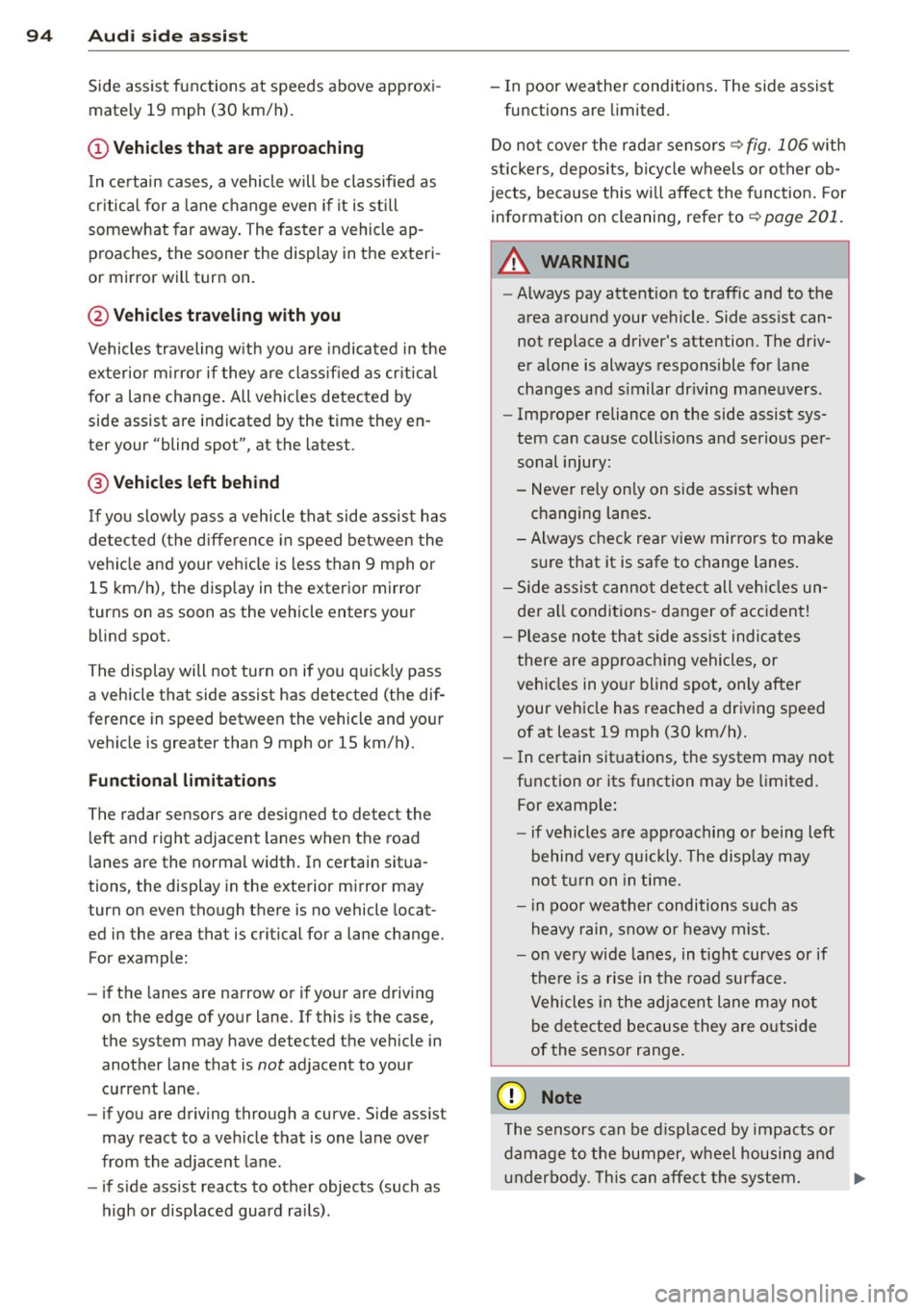
94 Audi side assist
Side assist functions at speeds above approxi
mately 19 mph (30 km/h).
(D Vehicles that are approaching
I n certain cases, a vehicle will be classified as
cr itica l for a lane change even if it is still
somewhat far away . The faster a vehicle ap
proaches, the sooner the display in the exteri
or mirror will turn on.
@ Vehicles traveling with you
Vehicles traveling with you are indicated in the
exterior m irror if they are classified as critica l
for a lane change. All vehicles detected by
side assist are indicated by the time they en
ter your "blind spot", at the latest.
@ Vehicles left behind
If you slowly pass a vehicle that side assist has
detected (the difference in speed between the
vehicle and your vehicle is less than 9 mph or
15 km/h), the disp lay in the exterior mirror
turns on as soon as the vehicle enters your blind spot.
The display will not turn on if you quickly pass
a vehicle that side assist has detected (the dif
ference in speed between the vehicle and your
vehicle is greater than 9 mph or 15 km/h).
Functional limitations
The radar sensors are designed to detect the
left and right adjacent lanes when the road
lanes are the normal width. In certain situa
tions, the display in the exterior mirror may
turn on even though there is no vehicle locat
ed in the area that is critical for a lane change.
For example:
- if the lanes are narrow or if your are driving
on the edge of your lane. If this is the case,
the system may have detected the vehicle in
another lane that is
not adjacent to your
current lane.
- if you are driving through a curve. Side assist
may react to a veh icle that is one lane over
from the adjacent lane.
- if side assist reacts to other objects (such as
high or displaced guard ra ils). -
In poor weather conditions . The side assist
functions are limited.
Do not cover the rada r senso rs
~ fig. 106 with
stickers, deposits, bicycle wheels or other ob
jects, because this will affect the funct ion . For
information on cleaning, refer to
~ page 201.
A WARNING
-
- Always pay attention to traffic and to the
area around your vehicle. Side assist can
not replace a driver's attention. The driv
er alone is always responsible for lane
changes and similar dr iving maneuvers .
- Improper reliance on the side assist sys
tem can cause coll is ions and serious per
sonal injury:
- Never rely on ly on side assist when
changing lanes.
- Always check rear view mirrors to make
sure that it is safe to change lanes.
- Side assist cannot detect all vehicles un
der all conditions -danger of accident!
- Please note that side assist indicates
there are approaching vehicles, or
vehicles in your blind spot, only after
your vehicle has reached a driving speed
of at least 19 mph (30 km/h).
- In certain sit uations, the system may not
function or its function may be limited.
For example:
- if vehicles are approaching or being left
behind very quickly. The disp lay may
not turn on in time.
- in poor weather conditions such as
heavy rain, snow o r heavy mist.
- on very wide lanes, in tight curves or if
there is a rise in the road surface.
Vehicles in the adjacent lane may not
be detected because they are outside
of the sensor range .
([) Note
The sensors can be displaced by impacts or
damage to the bumper, wheel housing and
u nderbody. This can affect the system. .,..
Page 230 of 302
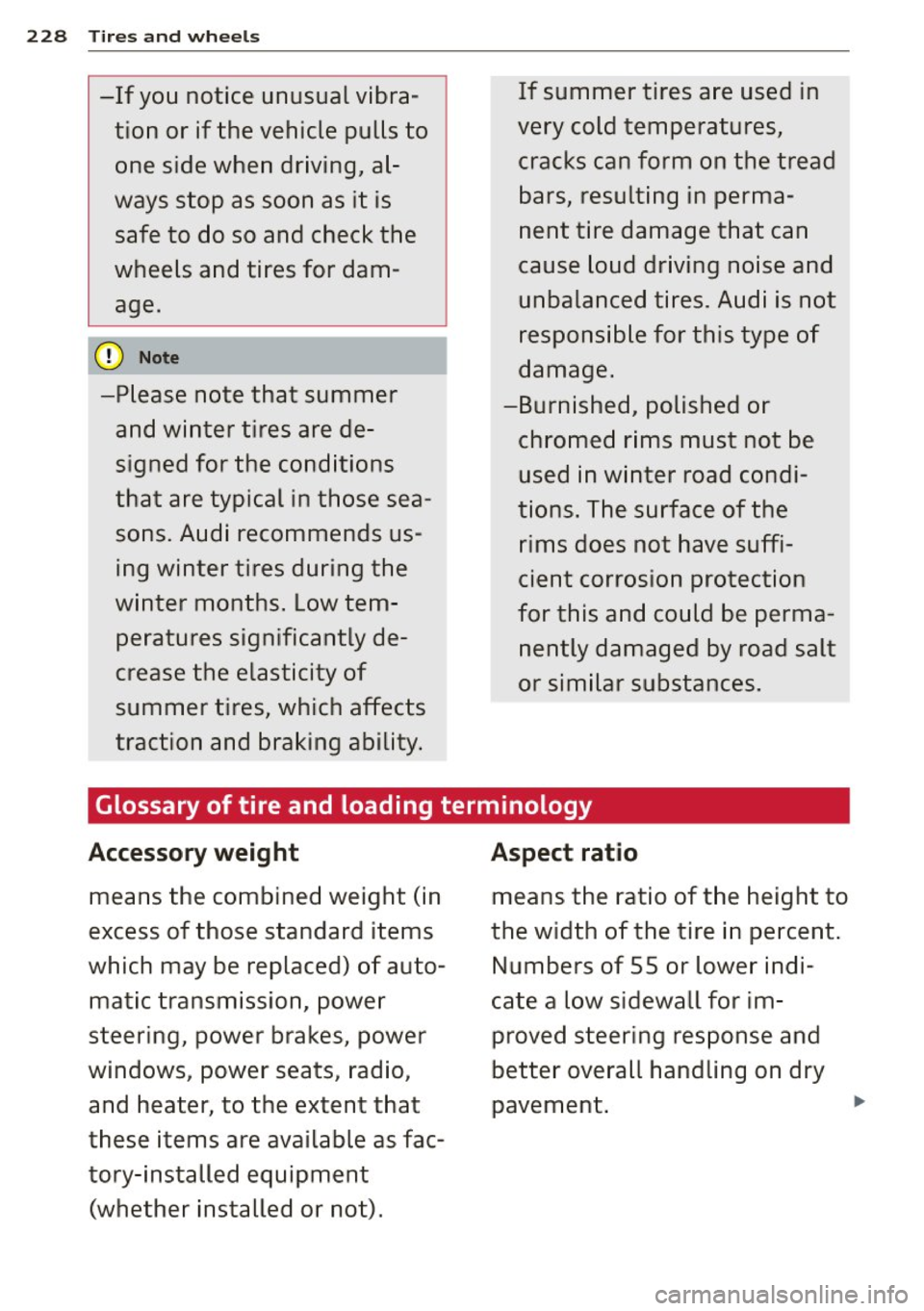
228 Tires and wheels
-If you notice unusual vibra
tion or if the vehicle pulls to
one side when driving, al
ways stop as soon as it is
safe to do so and check the
wheels and tires for dam
age.
0 Note
-Please note that summer and winter tires are de
signed for the conditions
that are typical in those sea
sons. Audi recommends us
ing winter tires during the
winter months. Low tem peratures significantly de
crease the elasticity of
summer tires, which affects
traction and braking ability. If summer tires are used
in
very cold temperatures, cracks can form on the tread
bars, resulting in perma
nent tire damage that can
cause loud driving noise and
unbalanced tires. Audi is not
responsible for this type of
damage.
-Burnished, polished or chromed rims must not be used in winter road condi
tions. The surface of the
rims does not have suffi
cient corrosion protection
for this and could be perma
nently damaged by road salt
or similar substances.
Glossary of tire and loading terminology
Accessory weight
means the combined weight (in
excess of those standard items
which may be replaced) of auto matic transmission, power
steering, power brakes, power
windows, power seats , radio,
and heater, to the extent that
these items are available as fac
tory-installed equipment (whether installed or not).
Aspect ratio
means the ratio of the height to
the width of the tire in percent.
Numbers of 55 or lower indi
cate a low sidewall for im
proved steering response and
better overall handling on dry
pavement.
...
Page 232 of 302

230 Tires a nd whee ls
Ma ximum load rating
means the load rating for a tire
at the maximum permissible in
flation pressure for that tire.
Maximum loaded vehicle
weight
means the sum of:
(a) Curb weight
(b) Accessory weight
(c) Vehicle capacity weight, and
(d) Production options weight
Maximum (permissible)
inflation pressure
means the maximum cold infla
tion pressure to which a tire
may be inflated. Also called
"maximum inflation pressure."
Normal occupant weight
means 150 lbs. (68 k ilograms)
times the number of occupants seated in the vehicle up to the
total seat ing capac ity of your
vehicle.
Occupant distribution
means distribution of occu
pants in a vehicle .
Outer diameter
means the overall diameter of
an inflated new tire.
Overall width
means the linear distance be
tween the ex teriors of the side
walls of an inflated tire, includ
ing elevations due to labeling,
decorations, or protect ive
bands or ribs .
Ply
means a layer of rubber -coated
parallel cords .
Production options weight
means the comb ined we ight of
those installed regular produc
tion op tions weighing over 5
lbs . (2. 3 kg) in excess of those
standard items which they re
place, no t prev iously consid
ered in curb weight or accessory
weight , incl uding heavy duty
brakes, ride leve lers, roof rac k,
heavy duty bat tery, and spec ial
trim.
Radial ply tire
means a pneumatic tire in
wh ich the p ly c ords that extend
t o the beads are laid at sub
stantially 90 degrees to the
centerline of the t read .
Page 233 of 302
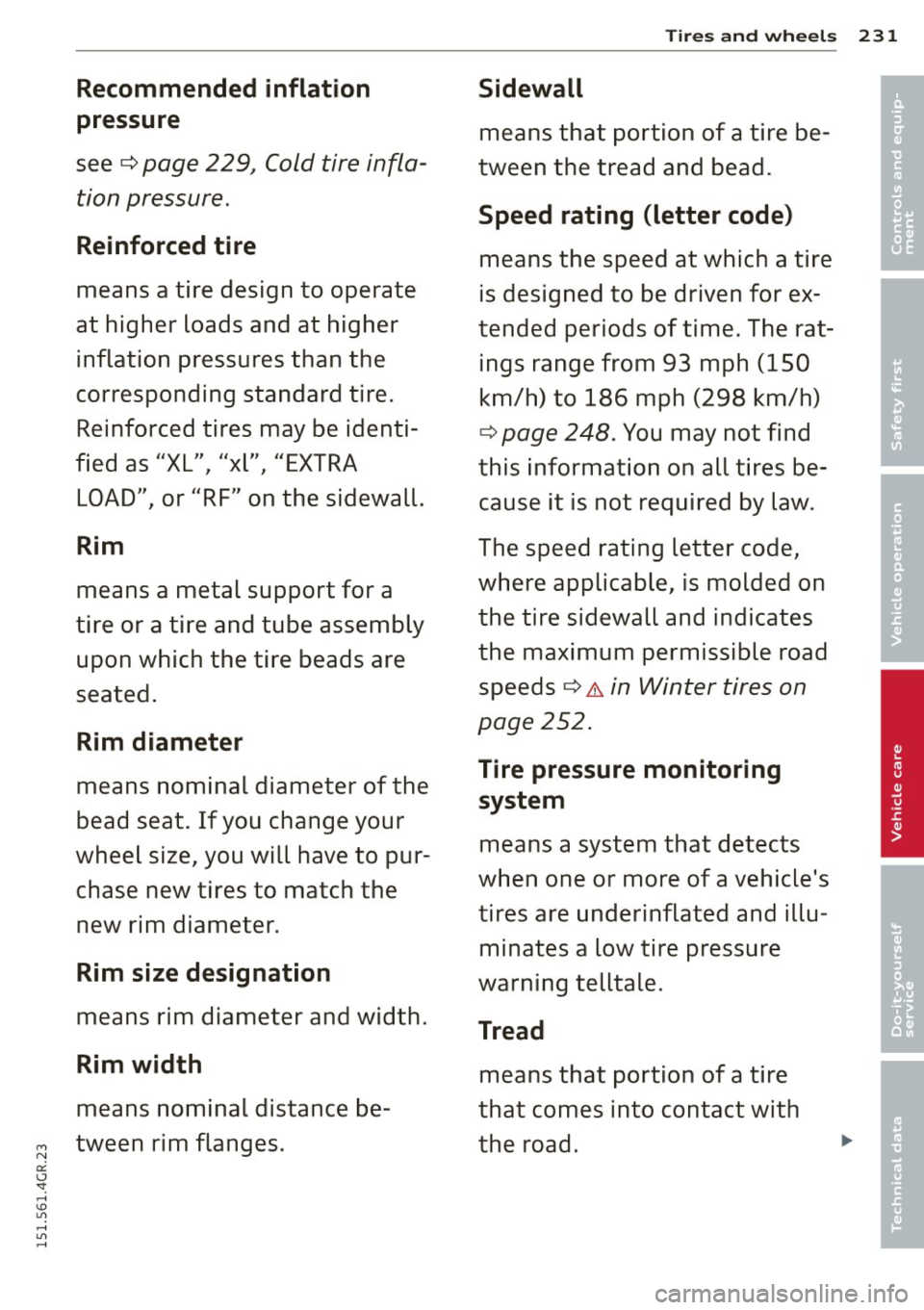
Recommended inflation
pressure
see¢ page 229J Cold tire infla
tion pressure.
Reinforced tire
means a tire design to operate
at higher loads and at higher
inflation pressures than the
corresponding standard tire. Reinforced tires may be identi
fied as "XL", "xl", "EXTRA
LOAD", or "RF" on the sidewall.
Rim
means a metal support for a
tire or a tire and tube assembly
upon which the tire beads are
seated.
Rim diameter
means nominal diameter of the
bead seat. If you change your
wheel size, you will have to pur chase new tires to match the
new rim diameter.
Rim size designation
means rim diameter and width.
Rim width
means nominal distance be
~ tween rim flanges.
0:: <.J 'SI: ,...., \!) 1.1'1 ,...., 1.1'1 ,....,
Tires and wheels 231
Sidewall
means that portion of a tire be
tween the tread and bead.
Speed rating (letter code)
means the speed at which a tire
is designed to be driven for ex
tended periods of time. The rat ings range from 93 mph (150
km/h) to 186 mph (298 km/h)
¢
page 248. You may not find
this information on all tires be cause it is not required by law.
The speed rating letter code,
where applicable, is molded on
the tire sidewall and indicates
the maximum permissible road speeds ¢
A in Winter tires on
page 252.
Tire pressure monitoring system
means a system that detects
when one or more of a vehicle's tires are underinflated and illu
minates a low tire pressure
warning telltale.
Tread
means that portion of a tire
that comes into contact with
the road.
•
•
'
Page 247 of 302
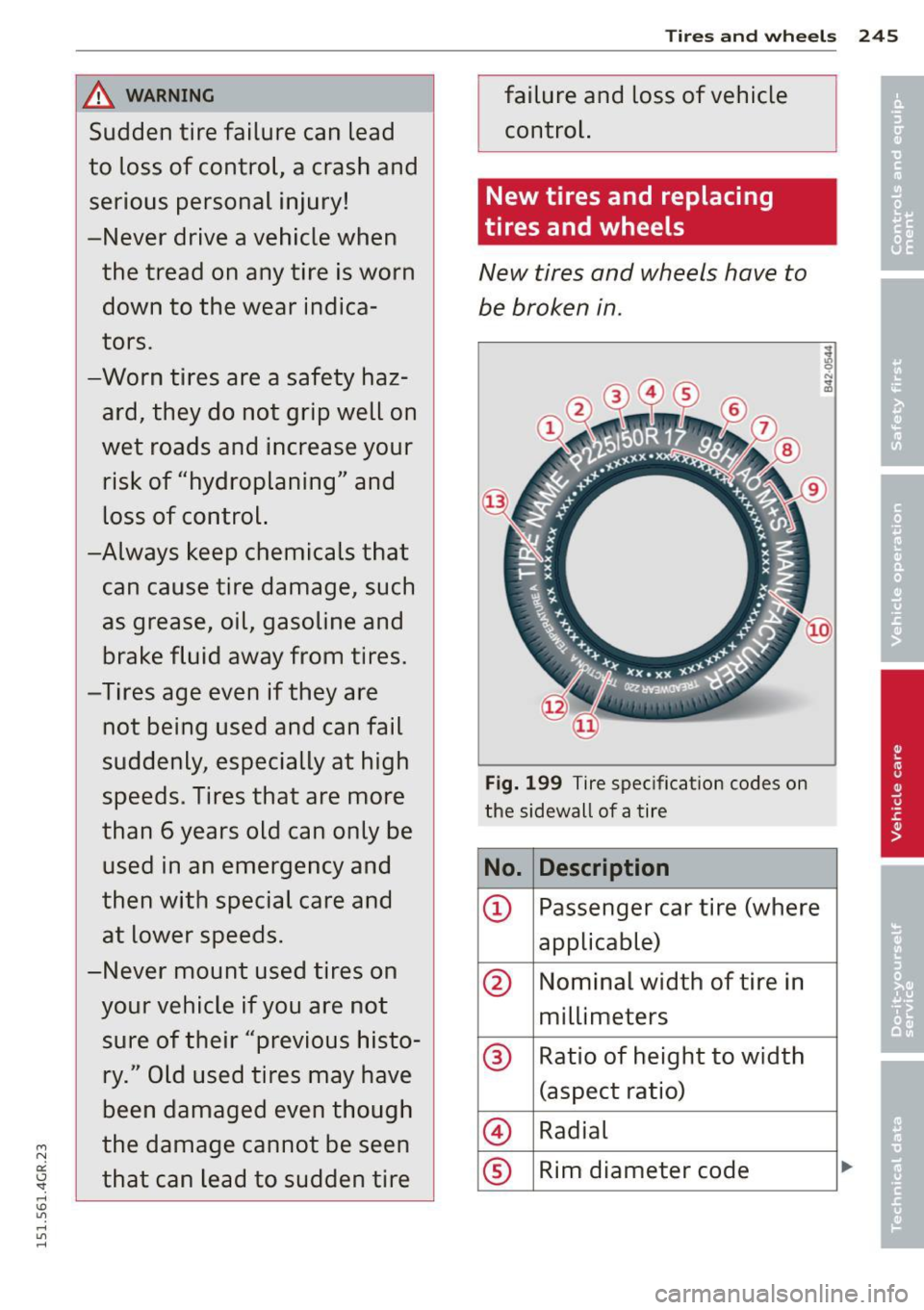
"' N
a:: I.J "". rl I.O
"' rl
"' rl
_&. WARNING
Sudden tire failure can lead
to loss of control, a crash and serious personal injury!
-Never drive a vehicle when the tread on any tire is worn down to the wear indica
tors.
-
-Worn tires are a safety haz ard, they do not grip well on
wet roads and increase your risk of "hydroplaning" and
loss of control.
-Always keep chemicals that can cause tire damage, such
as grease, oil, gasoline and brake fluid away from tires.
-Tires age even if they are not being used and can fail
suddenly, especially at high
speeds. Tires that are more
than 6 years old can only be used in an emergency and
then with special care and at lower speeds.
-Never mount used tires on your vehicle if you are not sure of their "previous history." Old used tires may have
been damaged even though
the damage cannot be seen
that can lead to sudden tire
Tires and wheels 245
failure and loss of vehicle control.
New tires and replacing
tires and wheels
New tires and wheels hove to
be broken in.
Fig. 199 Tire specification codes on
the sidewall of a tire
No. Description
CD Passenger car tire (where
applicable)
0 Nominal width of tire in
millimeters
® Ratio of height to width
(aspect ratio)
© Radial
® Rim diameter code
Page 249 of 302
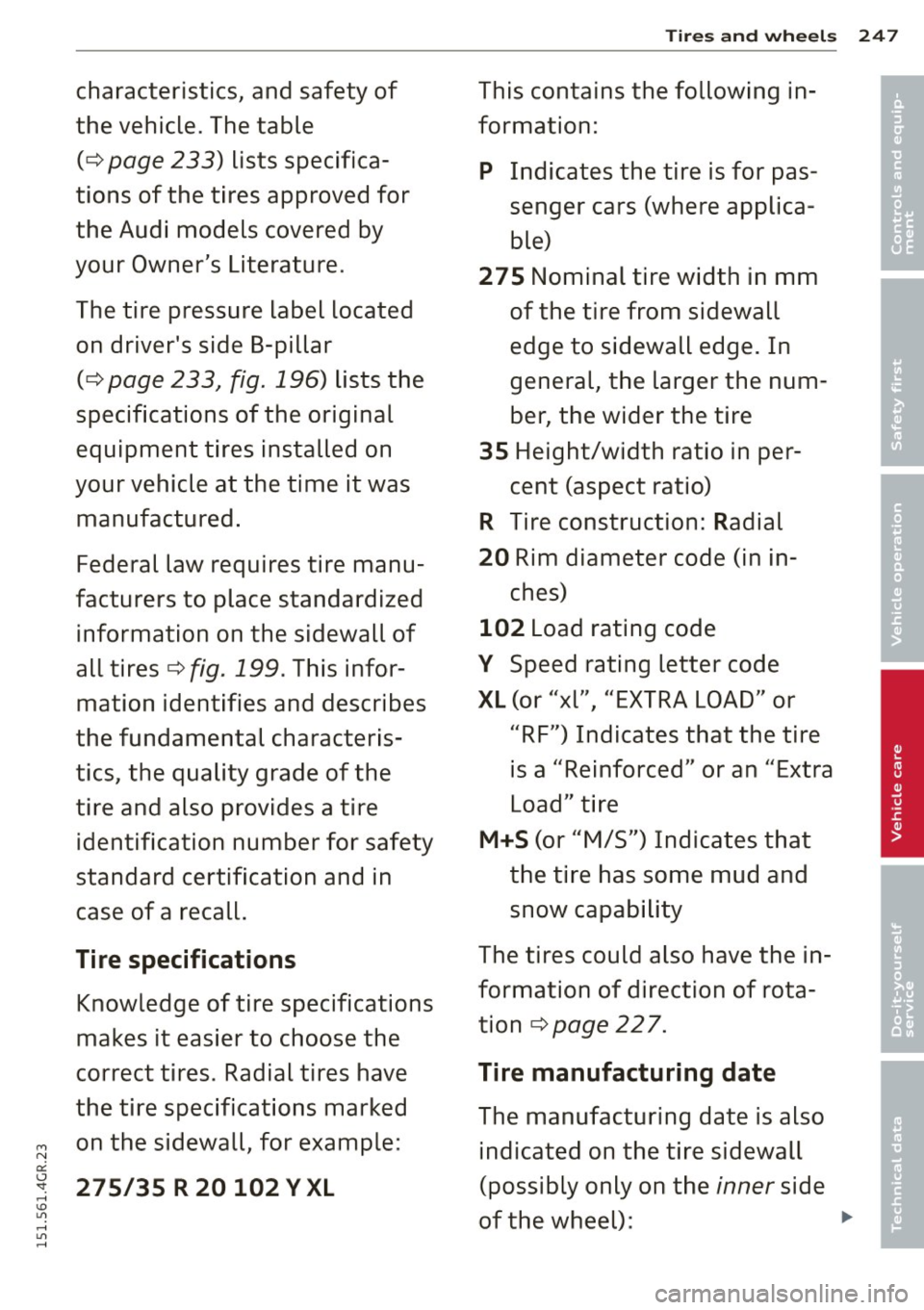
Tires and wheels 24 7
characteristics, and safety of This contains the following in-•
the vehicle. The table formation: • '
(¢ page 233) lists specifica-p Indicates the tire is for pas-
tions of the tires approved for senger cars (where applica-
the Audi models covered by ble)
your Owner's Literature .
275 Nominal tire width in mm
The tire pressure label located of the tire from sidewall
on driver's side B-pillar edge to sidewall edge. In
( ¢
page 233~ fig. 196) lists the
general, the larger the num-
specifications of the original ber, the wider the tire
equipment tires installed on
35 Height/width ratio in per-
your vehicle at the time it was cent (aspect ratio)
manufactured.
R Tire construction: Radial
Federal law requires tire manu-
20 Rim diameter code (in in-
facturers to place standardized ches)
information on the sidewall of
102 Load rating code
all tires ¢
fig. 199. This infor-Y Speed rating letter code
mation identifies and describes
XL (or "xl", "EXTRA LOAD" or
the fundamental characteris- "RF
") Indicates that the tire
tics, the quality grade of the is a "Reinforced" or an "Extra
tire and also provides a tire Load" tire
identification number for safety
M+S (or "M/5") Indicates that
standard certification and in the tire has some mud and
case of a recall. snow capability
Tire specifications The tires could also have the in-
Knowledge of tire specifications formation of direction of rota-
tion
c:::> page 22 7.
makes it easier to choose the
correct tires . Radial tires have
Tire manufacturing date
the tire specifications marked
The manufacturing date is also
M on the sidewall, for example: indicated on the tire sidewall N
0:: <.J
275/35 R 20 102 Y XL (possibly only on the inner side 'SI: ,...., \!)
of the wheel): 1.1'1 .... ,...., 1.1'1 ,....,
Page 253 of 302
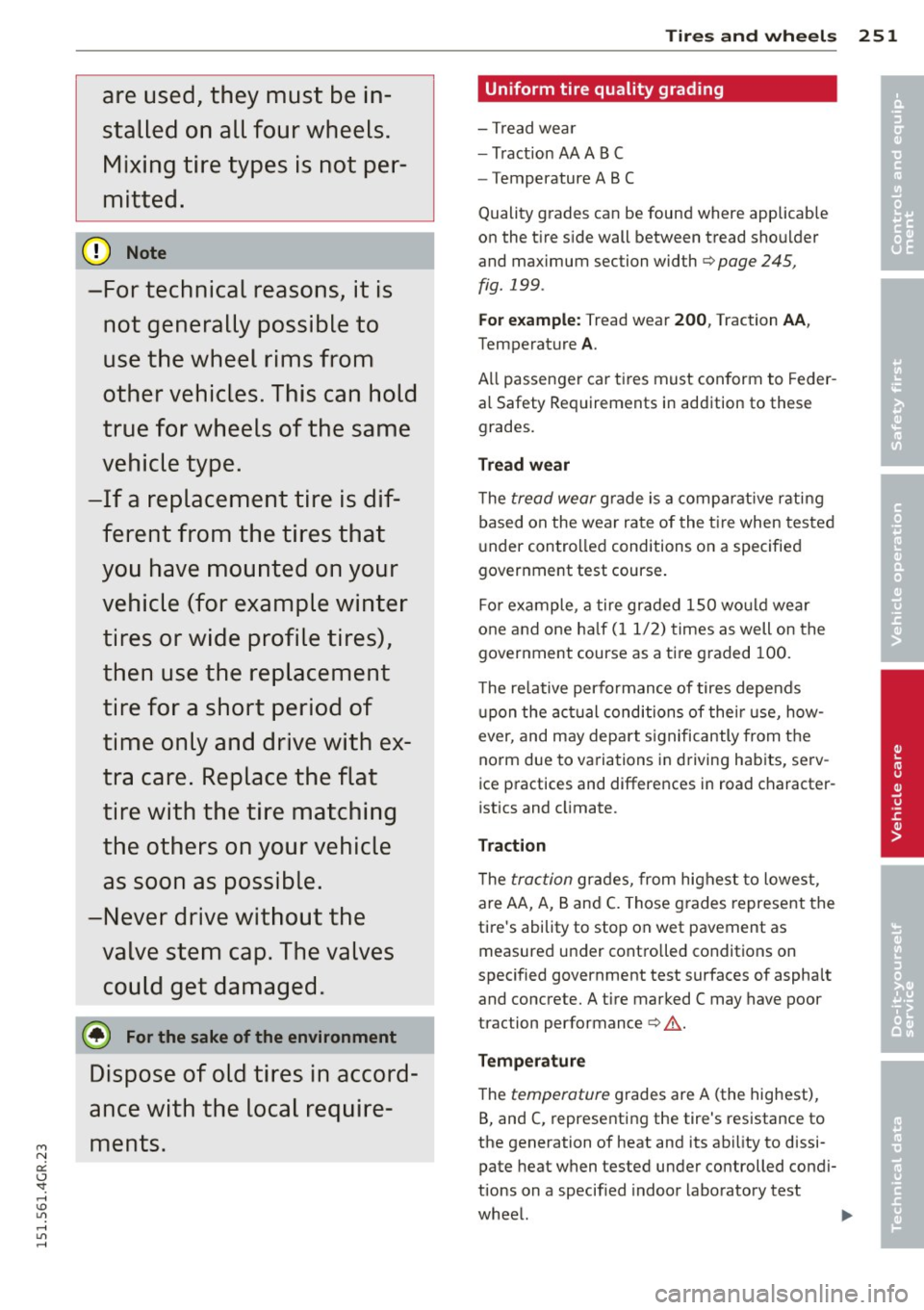
M N
0:: <.J 'SI: ,...., \!) 1.1'1 ,...., 1.1'1 ,....,
are used , they must be in
stalled on all four wheels. Mixing tire types is not per
mitted.
(D Note
-For technical reasons, it is not generally possible to
use the wheel rims from
other vehicles. This can hold
true for wheels of the same
vehicle type.
- If a replacement tire is dif
ferent from the tires that
you have mounted on your
vehicle (for example winter
tires or wide profile tires),
then use the replacement
tire for a short period of
time only and drive with ex
tra care. Replace the flat
tire with the tire matching
the others on your vehicle
as soon as possible.
- Never drive without the
valve stem cap. The valves
could get damaged .
@) For the sake of the environment
Dispose of old tires in accord
ance with the local require ments.
Tires and wheels 251
Uniform tire quality grading
- Tread wea r
- Traction AA A B C
- Temperature AB C
Quality g rades ca n be foun d where applicab le
on the t ire s ide wall between t read sho ulder
and maximum section width
c> page 245,
fig. 199 .
For example : Tread wear 200, Traction AA,
Temperat ure A.
All passenge r ca r tir es must con form to Feder
a l Safety Requ irements in add ition to these
grades.
Tread wear
T he tread we ar g rade is a c omp arati ve r ati ng
based on the wea r rat e of the tire when tes te d
u nder con tro lled conditions o n a specifie d
government test course .
F o r ex ample, a tire gr aded 1S 0 wo uld wear
one a nd one h alf ( 11 /2 ) times as well on the
governmen t course as a ti re g raded 100 .
T he re la tive perfo rman ce of tires depe nds
up on the actu al c ondition s of the ir u se, how
ever, and m ay dep art s ignificantly from t he
no rm due to va ria tions i n driving ha bits, se rv
ice p ractices and differences in road c haracter
istics and cl imate.
Traction
T he trac tio n gr ad es, from hig hest to lowes t,
a re AA, A, Ban d
C. Those g rades represe nt the
ti re 's ability to stop on wet pavement as
measured u nder cont rolled conditions on
specified government test surfaces of aspha lt
and concrete. A t ire mar ked C may have poor
traction performance
c> ,&. .
Temperature
The temperature gr ades are A (the highest),
B, and C, represent in g the tire's resistance to
the generation of heat and its ab ility to d issi
pate heat when tested un der controlled condi
tions on a specif ied indoo r labo rato ry test
whee l.
•
•
Page 256 of 302
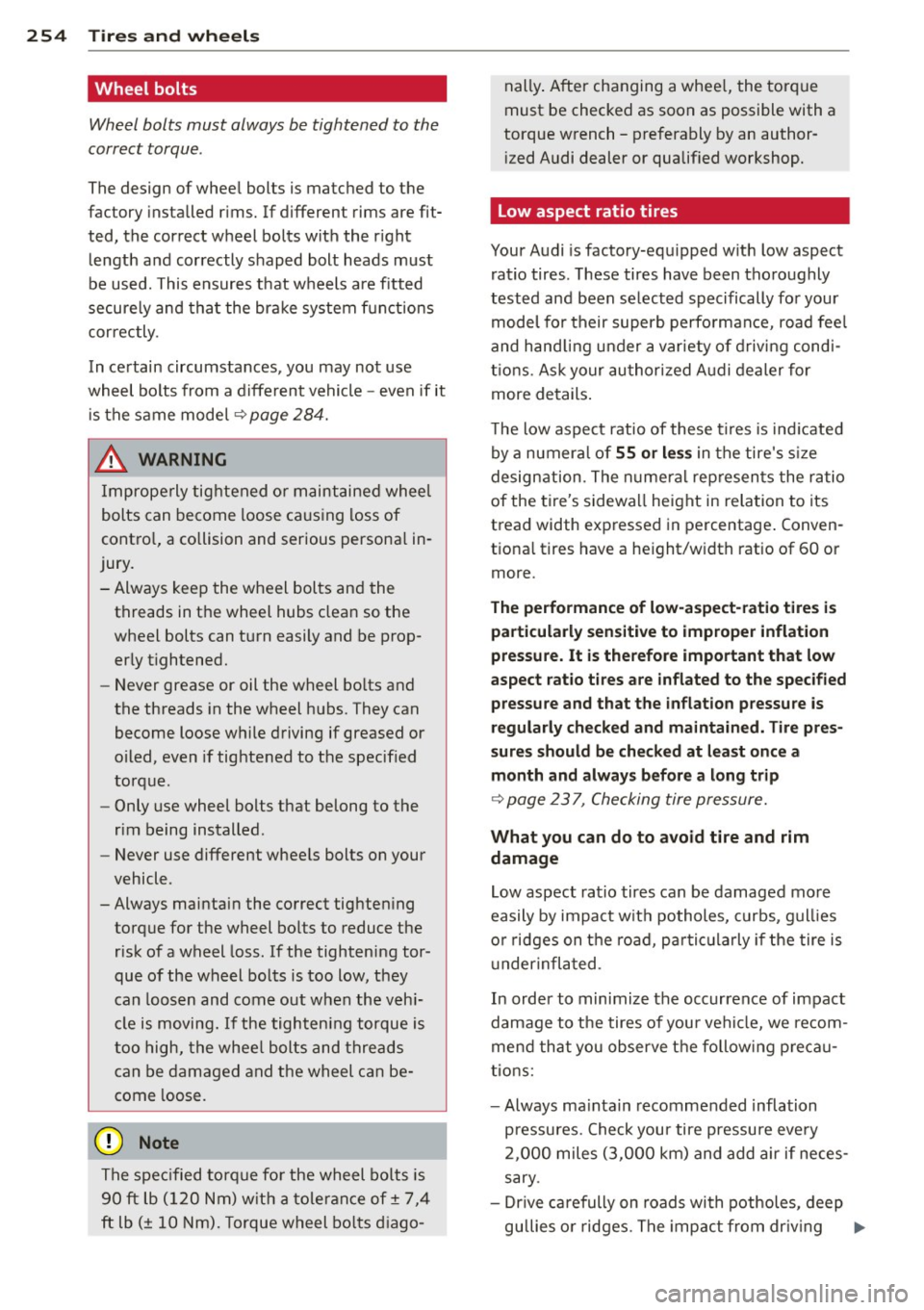
254 Tire s and wheel s
Wheel bolts
Wheel bolts must always be tightened to the
correct torque .
The design of wheel bolts is matched to the
factory installed rims. If different rims are fit
ted, the correct wheel bolts with the r ight
length and correctly shaped bolt heads must
be used. This ensures that wheels are fitted
secure ly and that the brake system funct ions
correctly .
In ce rtain circumstances, you may not use
wheel bolts from a different vehicle -even if it
i s the same mode l
~page 284.
_& WARNING
Improperly tig htened o r maintained whee l
bolts can become loose ca using loss of
contro l, a co llision and serious persona l in
jury.
- Always keep the wheel bolts and the
threads in the wheel hubs clean so the
wheel bolts can turn easily and be prop
erly t ightened.
- Never grease or oil the wheel bo lts and
the threads in the wheel hubs. They can
become loose while driving if greased or
oiled, even if tightened to the specif ied
torque.
- Only use wheel bolts that belong to the
rim being installed.
- Never use different wheels bolts on your
vehicle.
-Always maintain the correct tighten ing
torque for the wheel bo lts to reduce the
risk of a wheel loss. If the tightening tor
que of the wheel bolts is too low, they
can loosen and come out when the veh i
cle is moving. If the tightening torque is
too high, the whee l bolts and threads
can be damaged and the wheel can be
come loose.
@ Note
The spec ified torque fo r the wheel bo lts is
90 ft lb (120 Nm) w ith a tolerance of± 7,4
ft lb(± 10 Nm). Torque wheel bo lts diago- nally
. After changing a whee l, the torque
must be checked as soon as possible with a
torque wrench -preferably by an author
i zed Audi dealer or qualified workshop.
Low aspect ratio tires
Your Audi is factory-equ ipped w ith low aspect
ratio tires . These tires have been thoroughly
tested and been selected specifically fo r your
model for their superb perfo rmance, road fee l
and hand ling under a variety of d riving cond i
tions . As k your au thor ized A udi dealer for
more details .
T he low aspect ratio of these tires is ind icated
by a numera l of
55 or less in the tire's s ize
designation. The numera l represen ts the ratio
of the tire's sidewall height in relation to its
tread width expressed in percentage . Conven
tiona l tires have a height/width ratio of 60 or
more.
The perf orm ance of low- aspect-r atio tire s is
p ar ticu larly s ensitive to improper infl ati on
press ure . It is t here fore im portant that low
as pect rat io tires are infl ated to the spe cified
pre ssure and that the infl ation pressu re is
r e gularl y che ck e d and mainta in ed. Tire pre s
su res should b e check ed at least onc e a
month and alwa ys bef ore a long trip
~page 237, Checking tire pressure.
What you can do to a void tire and rim
damage
Low aspect ratio tires can be damaged more
easily by impact w it h potholes, curbs, gull ies
o r r idges on the road, pa rticularly if the tire is
u nderinfla ted .
In order to minimize the occurrence of impact
damage to the tires of you r vehicle, we recom
mend that you observe the follow ing p recau
tions:
- Always ma inta in recommended inflation
pressures. Check your tire pressure eve ry
2,000 miles (3,000 km) and add air if neces
sary .
- Dr ive carefully on roads with potholes, deep
gullies o r ridges. The impact from dr iv ing ..,.
Page 282 of 302
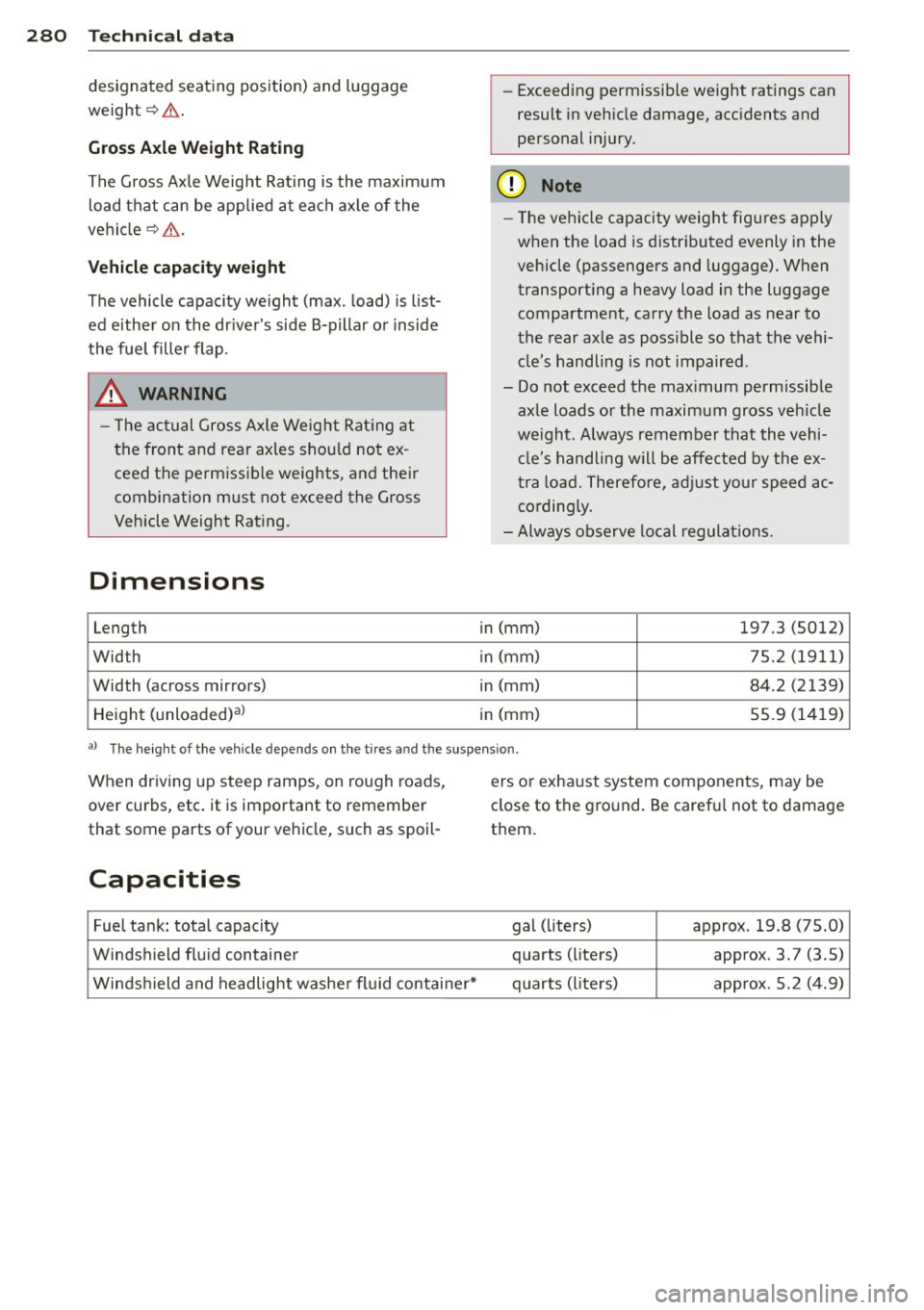
28 0 Techni cal data
designated s eating position) and luggage
w eight ¢.&, .
Gross Axle W eight Rating
The Gross Axle Weight Rating is the maximum
l oad that can be applied at each axle of the
vehicle ¢Lr!, .
Vehicle cap acit y weight
The vehicle capac ity we ight (max . load) is list
ed either on the dr iver's side B-pilla r or inside
the fuel filler flap.
_& WARNING
- T he actual Gross Axle Weight Rat ing at
the front and rear axles shou ld not ex
ceed the permissible weights, and their
combination must not exceed the Gross
Vehicle Weight Rating .
Dimensions
Length
Width
Width (across mirror s)
Height (unloaded) al
-
-Exceeding permissible weight ratings can
result in veh icle damage, acc idents and
personal injury.
(D Note
- The vehicle capacity weight figures apply
when the load is distributed evenly in the
vehicle (passengers and luggage). When
transport ing a heavy load in the luggage
compartment, carry the load as near to
the rear axle as poss ible so that the vehi
cle's handling is not impaired .
- Do not exceed the maximum permissible axle loads or the maximum gross veh icle
we ight. Always remember that the vehi
cle's handling w il l be affected by the ex
tra load. Therefo re, adj ust your speed ac
cordingly.
- Always observe local regulat ions .
in (mm )
197.3 (5012)
i n (mm) 75.2 (1911)
in (mm) 84.2 (2139)
in (mm) 55.9 (1419)
al The he igh t of the veh icle depen ds on the t ire s and th e su spen sion .
When driving up steep ramps, on rough roads,
over curbs, etc . it is important to remember
that som e parts of your veh icle, such as spoil-
Capacities
Fuel tank: total capacity
W indsh ield flu id conta iner
Winds hield and headlight washe r fluid containe ir* ers or exhaust system components, may be
close to
the ground . Be carefu l not to damage
them .
gal (liters) approx. 19 .8 (75.0)
quarts (liters) approx. 3. 7 (3.5)
quarts (liters) approx. 5.2 (4.9)